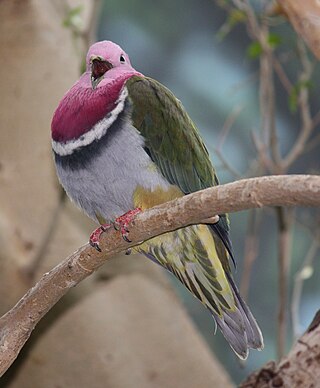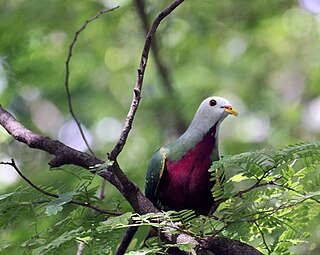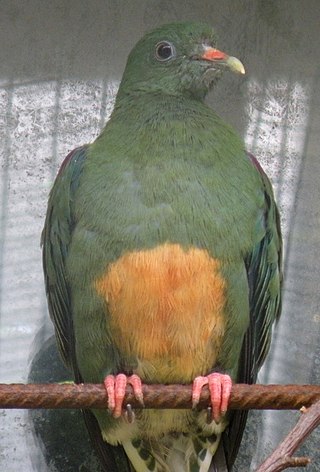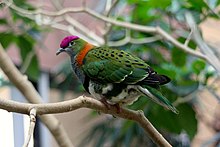
The pink-headed fruit dove also known as pink-necked fruit dove or Temminck's fruit pigeon, is a small colourful dove.

The jambu fruit dove is a smallish colourful fruit dove. It is a resident breeding species in southern Thailand, Malaysia, Brunei and the Indonesian islands of Kalimantan, Sumatra and Java.

The wompoo fruit dove, also known as wompoo pigeon and "magnificent fruit dove" among others, is one of the larger fruit doves native to New Guinea and eastern Australia.

The Mariana fruit dove or Marianas fruit dove, totot on Guam or Paluman totut in Northern Marianas Islands, also known as mwee’mwe in the Carolinian language, is a small, up to 24 cm long, green fruit dove native and endemic to Guam and the Northern Marianas Islands in the Pacific. It has a red forehead; greyish head, back and breast; and yellow belly patch and undertail coverts.

The black-chinned fruit dove, also known as the black-throated fruit dove or Leclancher's dove, is a medium-sized bird of the family Columbidae. The male is a colorful bird with a green belly and wings, a brown tail, a whitish grey head and neck with a purple base, red iris and a small black patch under its yellow bill. The female has a green head, neck and breast.

The beautiful fruit dove, also known as the rose-fronted pigeon or crimson-capped fruit dove, is a small, approximately 19 cm long, mainly green fruit dove. It has a red crown, whitish throat, a greenish-yellow bill and purplish-red feet. It has a blue-grey breast and yellowish orange belly, with a reddish purple patch in between. Both sexes are similar.

Wallace's fruit dove is a species of bird in the pigeon family Columbidae. The name commemorates the British naturalist Alfred Russel Wallace. It is a rather large, long-tailed fruit dove with a length of 24–28 cm (9.4–11.0 in) and has been described as "one of the most beautiful" fruit doves. The forehead and crown are dull crimson, the lower face and throat are white, and the rest of the head, breast, neck, and upper back are pale bluish-grey. The wings and lower back are green and the belly is orange, separated from the chest by a white band. Both sexes look similar, but females have less extensive red on the head and a greenish tinge to their grey parts.

The golden fruit dove, also known as the golden dove, lemon dove or yellow dove, is a small, approximately 20 cm (8 in) long, short-tailed fruit-dove in the family Columbidae. The common name refers to the males' bright golden-yellow colour. The body feathers appear almost iridescent due to their elongated shape and hair-like texture. The head is slightly duller with a greenish tinge. The bill, orbital skin and legs are bluish-green and the iris is whitish. The underwings and tail coverts are yellow. The female is a dark green bird with bare parts resembling those of the male. The young resembles the female.

The collared imperial pigeon is a large pigeon native to New Guinea and adjacent islands.

The rose-crowned fruit dove, also known as pink-capped fruit dove or Swainson's fruit dove, is a medium-sized, up to 22 cm long, green fruit dove with a grey head and breast, an orange belly, whitish throat, yellow-orange iris, and greyish green bill and feet. It has a pinkish-red crown with yellow border. The Indonesian subspecies, P. r. xanthogaster, has a whitish crown and paler grey head and breast. Both sexes are similar. The young has a green-colored crown and plumage.

The orange-bellied fruit dove is a small pigeon with mainly green plumage, distinguished by a large orange patch on the lower breast and belly, a small lilac shoulder patch, pale yellow undertail coverts, and a grey terminal band on the tail.

The white-capped fruit dove, also called kuku locally, is a species of bird in the family Columbidae. It was described by French naturalist and surgeon Adolphe-Simon Neboux in 1840. It is endemic to the Marquesas Islands in French Polynesia. The name honours French admiral and botanist Abel Aubert du Petit-Thouars. Two subspecies exist on the islands, Ptilinopus d. dupetithouarsii and Ptilinopus d. viridior.

The white-headed fruit dove is a species of bird in the pigeon family Columbidae. It was described by the English ornithologist John Gould in 1856, and the specific name eugeniae honours the French empress Eugénie de Montijo. Adults of the species have white heads, a purplish-red breast patch, a grey shoulder patch, olive-green upperparts, greenish underparts with a blue tinge, and a yellowish vent. Juveniles have green heads with the white restricted to the forehead and upper throat, a much smaller grey shoulder patch, and the red breast patch restricted to the centre of the breast.
The Henderson fruit dove, Henderson Island fruit dove or scarlet-capped fruit dove is a species of bird in the family Columbidae.

The dwarf fruit dove is a species of bird in the family Columbidae. It is found in lowland and foothill forest in New Guinea and the Raja Ampat Islands.The dwarf fruit dove weighs 49 grams, about equivalent to the weight of two AA batteries. This bird is the smallest in length of the fruit dove genus.

The many-colored fruit dove, also known as manuma in the Samoan language, is a species of bird in the family Columbidae. It occurs on islands in the south-west Pacific Ocean where it is found in Fiji, the Samoan Islands, and Tonga. Its natural habitat is subtropical or tropical moist lowland forests. Today, the birds are most often found in Fiji and Tonga. It usually feeds high in the canopy on fruit and berries, especially banyan fig. The nest is a small platform of twigs where one white egg is laid.

The crimson-crowned fruit dove, also the Tongan fruit dove or purple-capped fruit dove, is a species of bird in the family Columbidae. It is found in American Samoa, Fiji, Marshall Islands, Niue, Samoa, Tonga, and Wallis and Futuna Islands. Its natural habitats are subtropical or tropical moist lowland forest and subtropical or tropical mangrove forest.

The white-bibbed fruit dove is a species of bird in the family Columbidae.

Ficus obliqua, commonly known as the small-leaved fig, is a tree in the family Moraceae, native to eastern Australia, New Guinea, eastern Indonesia to Sulawesi and islands in the southwestern Pacific Ocean. Previously known for many years as Ficus eugenioides, it is a banyan of the genus Ficus, which contains around 750 species worldwide in warm climates, including the edible fig. Beginning life as a seedling, which grows on other plants (epiphyte) or on rocks (lithophyte), F. obliqua can grow to 60 m (200 ft) high and nearly as wide with a pale grey buttressed trunk, and glossy green leaves.

The fruit doves, also known as fruit pigeons, are a genus (Ptilinopus) of birds in the pigeon and dove family (Columbidae). These colourful, frugivorous doves are found in forests and woodlands in Southeast Asia and Oceania. It is a large genus with over 50 species, some threatened or already extinct.























